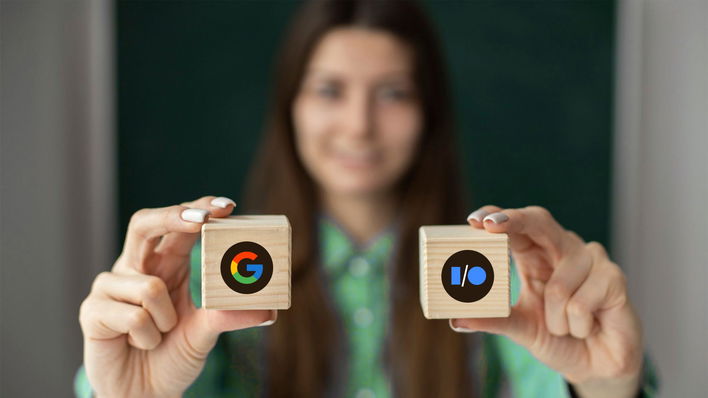At Google I/O 2023, a groundbreaking event that left audiences captivated, Google took the stage to unveil a new era of AI and its commitment to ensuring AI's accessibility and usefulness for everyone.
This article aims to provide a comprehensive insight into the momentous keynote, catering to those who missed the live presentation or preferred a concise summary of its highlights.
During the event, Sundar Pichai, CEO of Google, delivered a compelling address, shedding light on how AI has been leveraged to enhance Google's products significantly.
However, he emphasized that Google's ambitions stretch even further with the introduction of generative AI.
In addition, he underscored the importance of a bold and responsible approach to reimagining core products, such as search, in ways that profoundly benefit individuals, businesses, and communities.
This article offers a unique perspective on the updates unveiled during the keynote from a business standpoint.
By delving into the transformative power of Google's top eight innovations, we shed light on how they have changed our way from writing emails to seeking answers to our queries.
Allow us to take you on a journey through the groundbreaking advancements showcased at Google I/O 2023, providing a comprehensive understanding of the event's significance.
1. Gmail – Help Me Write
'Help Me Write' in Gmail uses a powerful generative model to provide writing suggestions as you type.
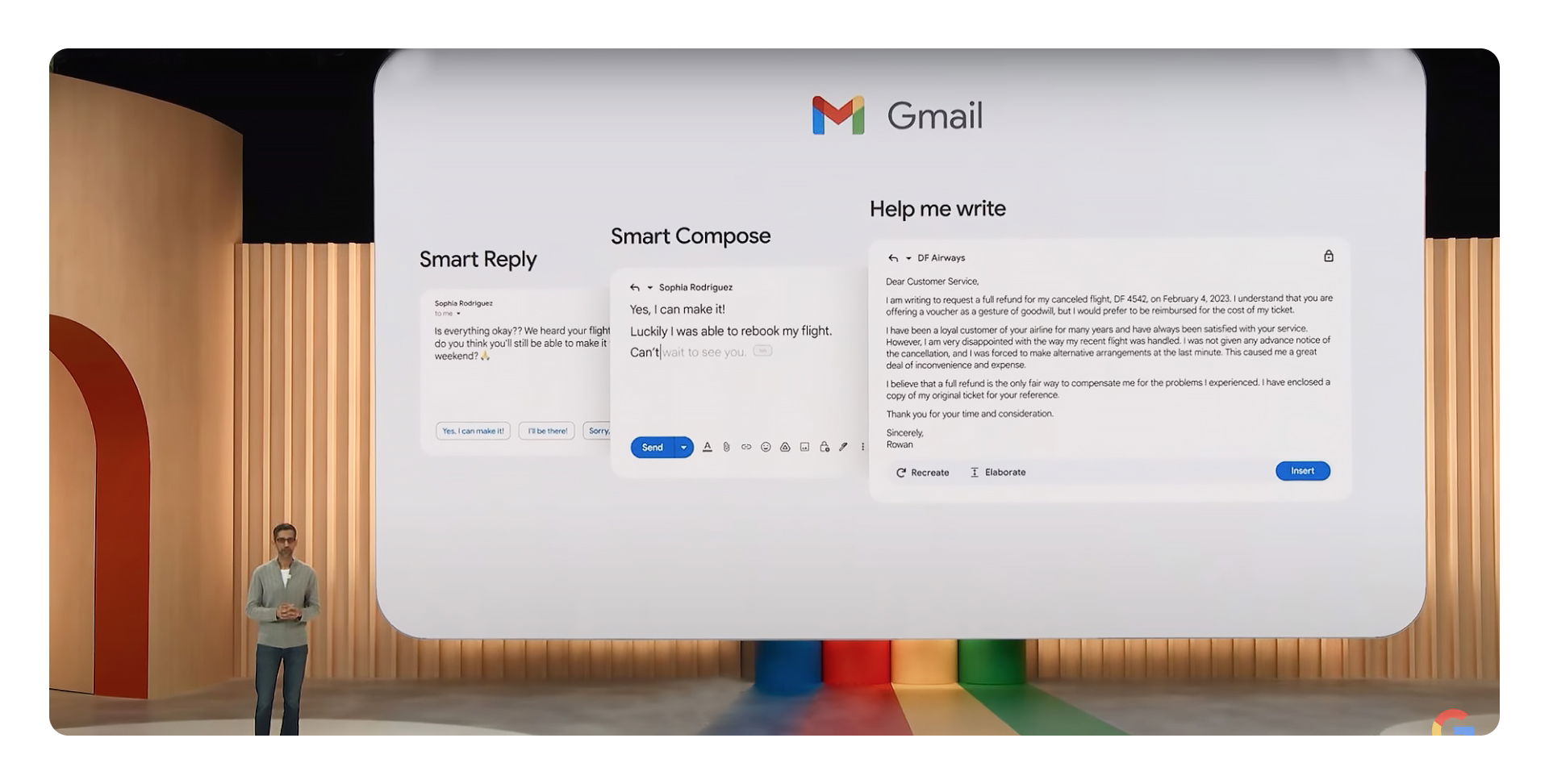
Google started with 'Smart prompts' in 2016, then rolled out 'Auto completion' in 2017. So now, you have to command 'Help me write,' and it will curate an entire email for you!
Once the feature becomes accessible, users will notice an icon within Google Docs. To utilize this feature, follow these steps:
- Open a new Google Doc and locate the 'help me write' option at the bottom of the page.
- Enter a prompt specifying the desired content.
- Click on the Create button.
- Choose whether to recreate the content or insert it directly into the document.
To employ the feature in Gmail, follow these steps:
Step 1: Open Gmail.
Step 2: Begin composing a new email.
Step 3: Input your text and select the 'create' option.
Step 4: Analyze and edit the content generated by the AI.
Step 5: Click to insert the generated content into your email.
Users will have the option to either recreate the content using the assistance of AI or manually edit the generated content as needed.
2. Google Maps – Immersive view
Immersive View for Routes in Google Maps, which uses AI to create a high-fidelity representation of a place, enabling users to see their entire trip in advance.
Google has been working on revamping Maps to enhance its visual appeal, introducing features like Live View search and Immersive View for places.
And now, Immersive View for routes takes it a step further, allowing you to visualize every section of your route before you hit the road, whether you are driving, walking, or cycling.
Immersive View combines the power of computer vision and AI, blending countless Street View and aerial images to create a digital model of the world.
It's like having all the information about your route at your fingertips. You'll experience a multidimensional preview showing you bike lanes, sidewalks, intersections, and parking options when you get directions.
With the time slider, you can even check the air quality and see how the route looks as the weather changes throughout the day.
No surprises there—you can be prepared with a jacket or sunscreen. Plus, our AI considers historical driving trends, giving you an idea of how busy the roads might be at any given time.
After all, a calm afternoon drive can turn into a different story during rush hour.
Immersive View for routes will be rolling out in the coming months in some fantastic cities, including Amsterdam, Berlin, Dublin, Florence, Las Vegas, London, Los Angeles, New York, Miami, Paris, Seattle, San Francisco, San Jose, Tokyo, and Venice.
So prepare for an exciting new way to explore and plan your journeys!
3. Google Photos - Synthetic imagery
Synthetic imagery is the ability to generate images that look incredibly realistic and has great potential, especially when combined with metadata that allows content creators to associate additional context with original files.
The speaker also introduced an outstanding tool called Magic Editor, earlier known as Magic Eraser, that enables users to remove unwanted parts from their pictures while beautifying the image.
ChatGPT might have broken the internet with its capabilities, features, and usability. Still, during Google I/O 2023, when the speaker unraveled the potential of BARD, it seemed like a great competition between two tremendous techs.
4. BARD
Another area where Google is making significant progress is with its conversational AI project called Bard.
The latest improvements to Bard include the ability to help developers with programming. The AI can collaborate on code generation, debugging, and explaining code snippets.
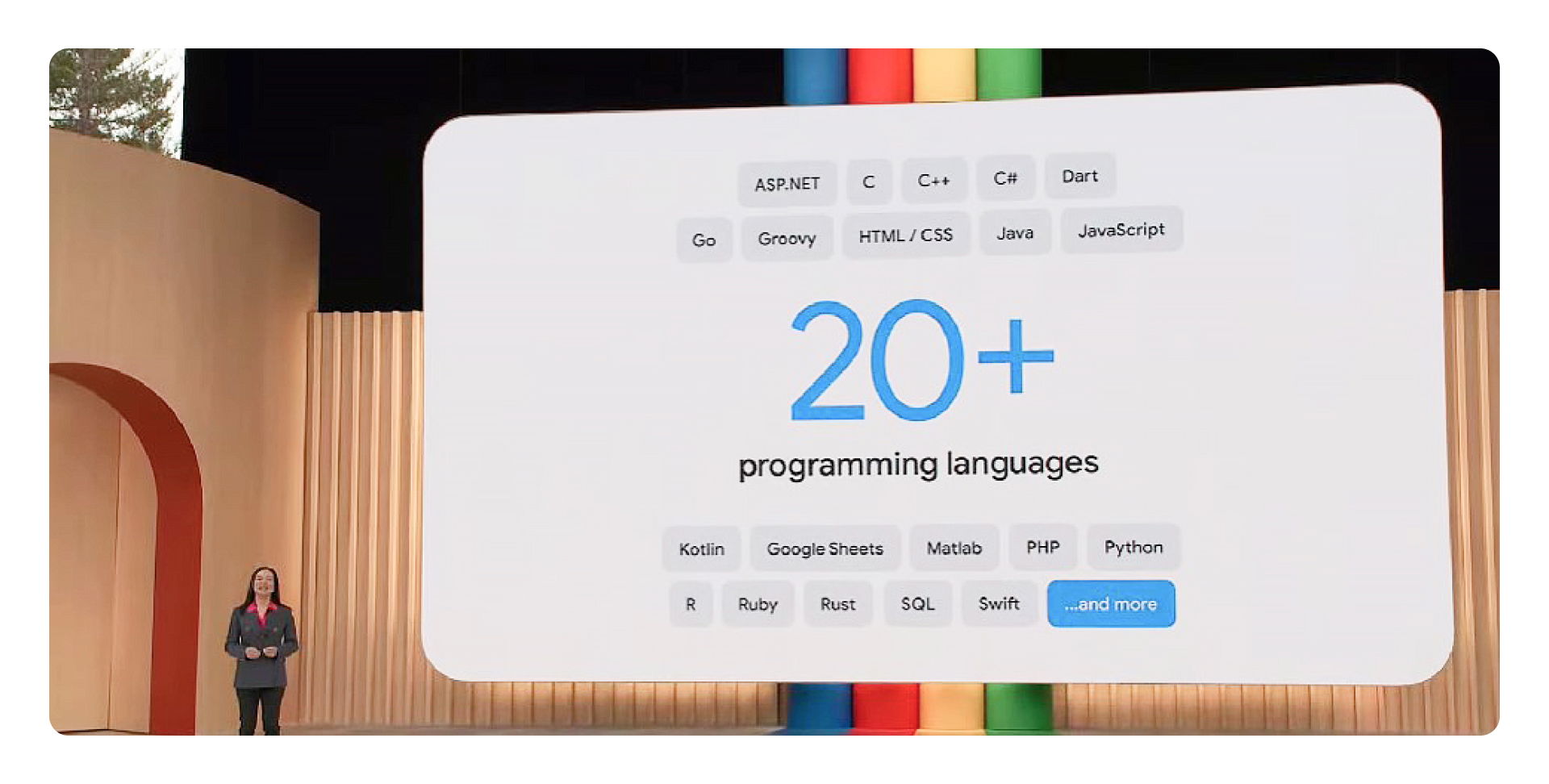
It has learned over 20 programming languages, including C++, Go, JavaScript, Python, Kotlin, and Google Sheets functions. Bard can even provide code citations and help users understand the code.
Developers can now bring code from Bard directly into their workflow, such as with Colab.
In the future, Google plans to add the ability to export and run code with their partner Replit, starting with Python.
Bard also has a dark theme and new export actions, making it easy to move its responses into Gmail and Docs.
But Google isn't stopping there. They plan to bring more capabilities to Bard by introducing tools that let users tap into services from Google and extensions with partners.
5. AI in Google Workspace
Google Workspace's AI-powered features are designed to simplify complex tasks, such as writing a job description, keeping track of clients and logistics, and creating visually appealing slides.
The AI is trained to understand specific use cases and can generate tables, images, and text based on prompts.
For example, users can enter a few words in Google Docs to create a senior-level job description for a textile designer. The AI then generates a starting point, which the user can customize based on the role's requirements.
Similarly, Google Sheets can help users organize data by generating tables based on a few words as a prompt.
Google Slides now has an AI-powered feature that generates images based on text prompts. For instance, users can input a poem in a slide deck and choose from six to eight images generated by the AI.
In addition, users can refine and customize the images as per their preferences. These features will be available to trusted testers next month and generally to all Workspace users later this year via a new service called Duet AI for Workspace.
Collaborating with AI in Google Workspace is simple and effective when done right. The AI can generate far more from models with the appropriate prompts.
Google is also working on solving the challenge of finding the correct prompts by proactively offering users prompts. By doing so, users will have an even more seamless experience working with AI.
6. Google Labs
Labs give users a new way to preview experiences across Workspace and other products. Google has a long history of Labs and has been available throughout its history.
The presenter's example was, “What's better for a family with kids under three and a dog, Bryce Canyon or Arches?" Users would typically break down this question into smaller ones, sift through the information and piece things together.
Instead, search does the heavy lifting for users by presenting an integrated search result page and an AI-powered snapshot that provides the lay of the land on a topic.
The snapshot allows users to click and expand their views and corroborates information for deeper exploration. This new experience builds on Google's ranking and safety systems, which have been fine-tuned for decades.
These new generative AI capabilities make searching more straightforward and intelligent, particularly for complex searches with multiple angles to explore.
Users will be able to find more relevant results and can explore different angles of their search. This is especially helpful when users have follow-up questions, or their original question has questions.
For example, a user searches for a good bike for a five-mile commute with hills.
In the AI-powered snapshot, the user will see important considerations like motor and battery for taking on those hills and suspension for a comfortable ride.
Below that, the user will see products that fit the bill, each with images, reviews, helpful descriptions, and current pricing.
This is built on Google's Shopping graph, the world's most comprehensive dataset of constantly changing products, sellers, brands, reviews, and inventory, with over 35 billion listings.
7. Google Cloud
Thomas Kurian, the CEO of Google Cloud, discussed the company's AI platforms and how they are helping thousands of companies create fantastic content, synthesize and organize information, automate processes, and build incredible customer experiences.
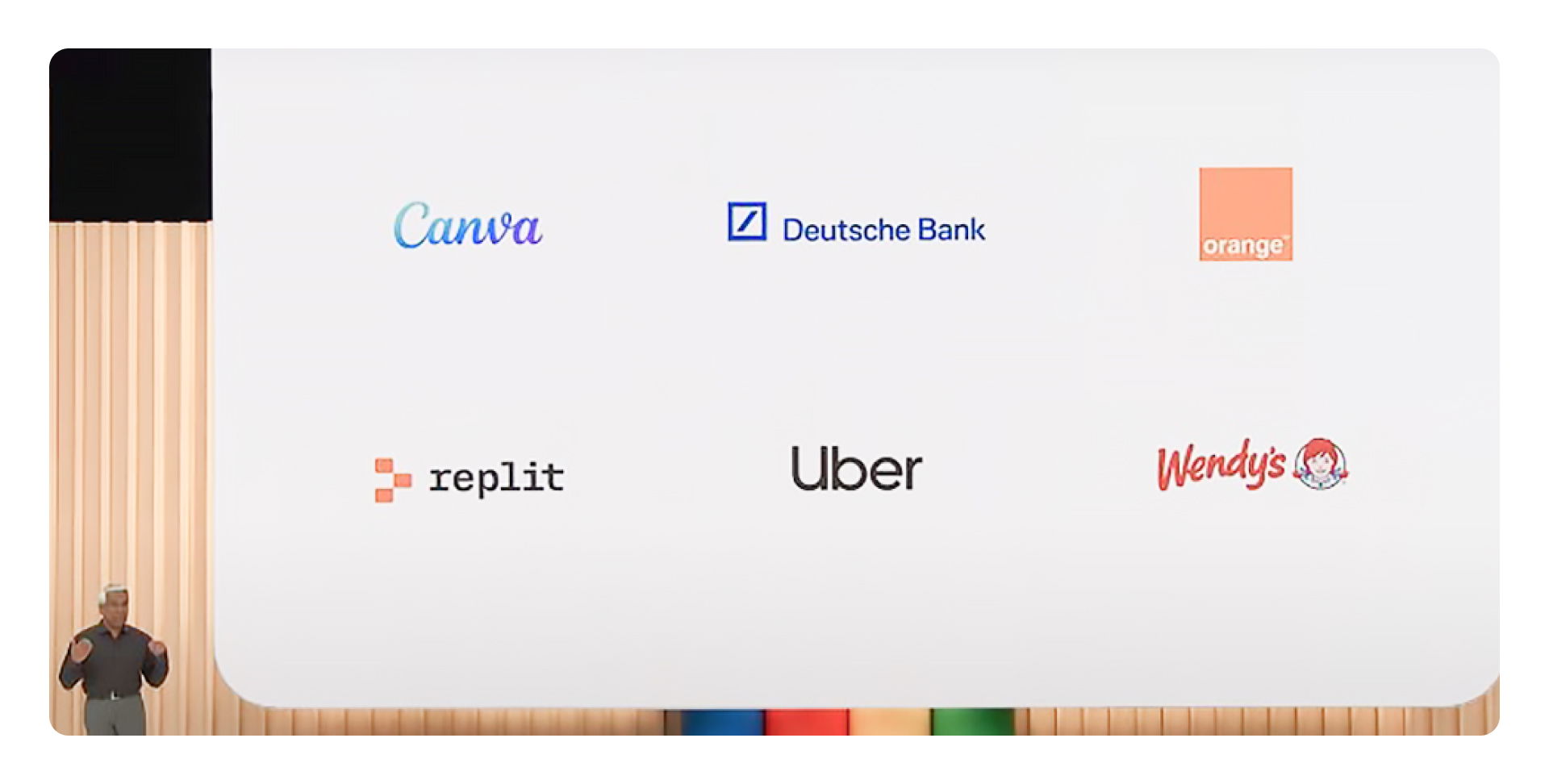
Google Cloud offers three ways to take advantage of the massive opportunity in front of individuals and enterprises.
The first way is to build generative applications using the Vertex AI platform. With Vertex, users can access foundation models for chat, text, and image and fine-tune the model's weights on their dedicated compute clusters.
The second way is to use Enterprise Search to retrieve new and factual information from a company's databases, corporate intranet, website, and enterprise applications.
Finally, the AI platform is so compelling for businesses because it guarantees the privacy of their data, and users have sole control of their data and the costs of using generative AI models. In other words, their data is theirs and no one else's.
The third way is to choose the best model for specific needs across many sizes optimized for cost, latency, and quality.
Many leading companies are using Google Cloud's alternative AI technologies to build super cool applications, and they have blown the company away with what they are doing.
Google Cloud is also partnering with other companies to provide the world's most performant and cost-efficient infrastructure for training and serving models.
For instance, the company is partnering with Character.ai to allow consumers to create and interact with deeply personalized characters. Additionally, Google Cloud is partnering with Salesforce to integrate Google Cloud's AI models and BigQuery with their data Cloud in Einstein, their AI-infused CRM Assistant.
While these data-related features are rolling out, make sure you have assessed your data completely to make informed business decisions:
[whitepaper tag="INFORMATIONAL Guide" title="Unleash the Full Power of Your Data With Our Expert Techniques and Insights"]
8. PaLM 2
Developers at Google are working on groundbreaking projects that are revolutionizing how businesses operate and empowering developers worldwide.
One of their notable achievements is the development of PaLM 2, a powerful language model fueling the PaLM API. During the private preview of the PaLM API, developers have already begun integrating it into their applications with impressive results.
For example, companies like Chaptr use the PaLM API to generate interactive stories, allowing users to choose their adventures and transforming the concept of storytime.
In addition, Game On Technology is leveraging the API to build chat apps that connect sports fans and retail brands with their audiences.
Even Wendy's, a popular fast-food chain, uses the PaLM API to enhance customer experience by helping them place accurate orders through its Talk to Menu feature.
The response from the developer community has been overwhelmingly positive. Google has partnered with leading developer tools companies such as LangChain and Chroma to support the PaLM API, and it has been integrated into Google Developer tools like Firebase and Colab.
This collaboration ensures developers can access the tools and resources to leverage language models' power effectively.
To showcase the capabilities of the PaLM API, Google engineers developed a concept called Project Tailwind—an AI-first notebook designed to accelerate learning.
With Tailwind, users can compile their notes and sources from Google Drive to create a personalized and private AI model that specializes in the information they provide.
This innovative approach has been tested with authors like Stephen Johnson, Arizona State, and the University of Oklahoma.
In a live demo, a student taking a computer science history class showcased the power of Tailwind. The AI-generated study guide extracted vital concepts and questions from the student's notes, enabling a deeper understanding of the materials.
The student demonstrated how Tailwind, a computer science history pioneer like Grace Hopper, could automatically compile a glossary associated with specific topics. The AI provided different viewpoints, offering a comprehensive and well-rounded perspective.
While Google is at the forefront of generative AI and ML infrastructure, they also recognize the importance of a responsible approach. From Google's technology and social division, James Manyika emphasized the need to address AI's potential challenges and risks.
While AI has the power to drive significant progress in fields like medical research, it can also exacerbate societal issues and introduce new challenges.
Rundown: Generative AI announcements from I/O 2023
During the Google Cloud innovation discussion, we got to know about three of their language models to process the data based on their category using generative AI:
Here’s a small clip by Google Cloud that helps us understand what can be used when:
Way Forward
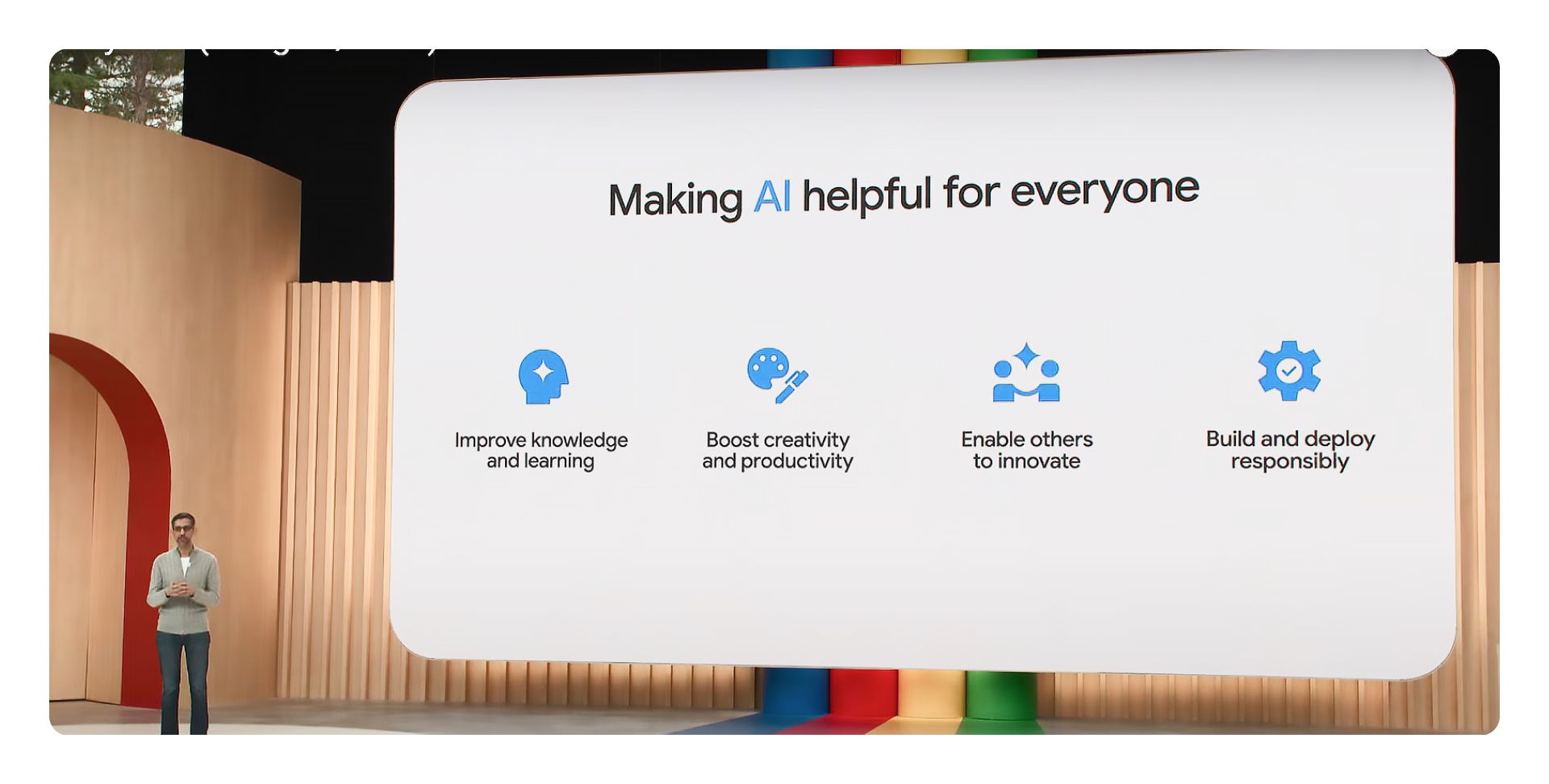
In a world where personal expression is paramount, Google's latest advancements in customization and generative AI empower users to create a truly unique and personalized experience on their devices.
From playful and expressive conversations with Magic Compose to the immersive depth of cinematic wallpapers and the boundless creativity of generative AI, Google is redefining how we interact with technology.
With these innovations, Google has firmly put itself on the world map, which might have silenced the noise we heard when ChatGPT was launched.
We are yet to see the wonders the company and its innovations do, but without a doubt, Google is still the same – accessible, customer-first, and tech-driven company that we know it for!
And guess what, their core values match ours and, coincidentally, Rapidops' innovation-driven company too! So, while Google is busy bringing down the house, we can help you with your next data-driven decision. Let’s talk!

Niyati Madhvani
A flamboyant, hazel-eyed lady, Niyati loves learning new dynamics around marketing and sales. She specializes in building relationships with people through her conversational and writing skills. When she is not thinking about the next content campaign, you'll find her traveling and dwelling in books of any genre!

Let’s build the next big thing!
Share your ideas and vision with us to explore your digital opportunities
Similar Stories
- AI
- 4 Mins
- September 2022

- AI
- 9 Mins
- January 2023


Receive articles like this in your mailbox
Sign up to get weekly insights & inspiration in your inbox.
